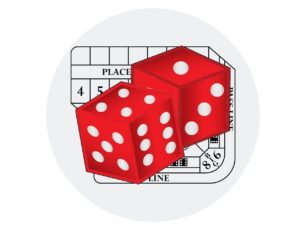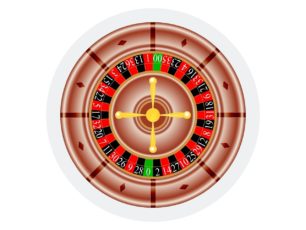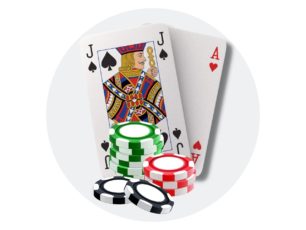How to Play Poker for Beginners
Well, despite the massive library of books you can find that try to break down the strategy of the game, the basic gameplay and rules of poker are actually quite simple.
When we strip away all of its tactics, strategy, and psychology, we find that poker is just a game in which players compare cards after a few rounds of betting in between. And from here, we can start to understand how the game is played.
What are the Rules of a Poker Game?
If you are at all familiar with poker, you probably already know that there are multiple variants of the game, each with its own set of rules. However, all of them more or less share the same general process of betting and comparing cards.
To illustrate this, let’s break down an example game of five-card draw poker with four players.
-
Rule number 1
At the beginning of the game, one of the players (either at random or by decision) is designated as the dealer of that round, and receives a button (also called a “buck”) to indicate their role. After a game is finished, the button is moved to the player to the left of the previous dealer. (Fun fact: this act of moving the button totf the next player is the origin of the phrase “passing the buck”.)
-
Rule Number 2
The player to the left of the dealer is then designated as the small blind, and the player to the left of the small blind is designated as the big blind. These two positions are so called because they have to place blind bets to start the game. These blind bets are made to discourage early folding—forcing a bet before the game begins incentivizes these positions to see the hand through in an attempt to recoup their blind.
The amount of the small and big blinds usually depends on the betting limits set by the table. Generally though, the big blind is usually equal to the minimum bet of the table, and the small blind is equal to half of the big blind. In the case of a bet limit of $2/$4, the big blind is $2 and the small blind is $1. (We’ll explain more about betting structures later.)
Some poker games will drop the blinds system in favor of the ante, a fixed bet that all players have to place at the start of each game. The ante amount is usually equal to the minimum bet of the table, and serves the same purpose as the blinds.
-
Rule Number 3
After the forced bets are posted (and collected in the pot), the dealer deals out five cards face-down to each player, starting with the small blind and progressing clockwise.
-
Rule Number 4
Each player gets their turn to make one of 5 actions: call, raise, re-raise, fold, or check.
The call matches the bet amount of the player before us in the sequence (the player to our right). In our example, calling the big blind of $2 means we have to place our own bet of $2.
The raise increases the wager over the one placed by the player before us in the sequence. This also increases the bet amount that the player after us has to call. So in our example, raising means placing a bet of $4. (The exact increments that players may raise their bet to depends on the betting structure of the table.)
The re-raise is exactly the same as the raise, but is given its own distinct name to indicate that a raise was performed by the previous player in the sequence. In our example, if the player after us re-raises our raise of $4, their wager must be $6 or higher.
Check is the poker term for passing one’s turn, in which the player does not make any changes to their bet and the turn moves to the next player in the sequence. A player can only check if the previous player made no action—in practice, this means that the small blind has the sole ability to initiate a check, as they are the first to act in the sequence and therefore has no action before their turn.
To fold is to forfeit the game. The player discards their hand and gives up any wagers that they made, then waits until the next game begins. As we’ve established earlier, both of the blinds are unable to fold in the first round of betting.
The betting round is completed when all players have taken non-aggressive actions (call, check, or fold), as opposed to aggressive actions (bet or raise). If any player during the sequence raises, all the other players get another chance to act. (To prevent continuous raises, the table will have a limit on how many raises can be done per round, usually 3).
-
Rule Number 5
Once the betting round is complete, the draw begins. In this round, each player in sequence is given the choice to discard any of the cards in their hand and have them replaced with new ones from the deck. Players also have the option to stand pat, or not replace any cards.
-
Rule Number 6
After the draw comes another round of betting, similar to Step 3. In this second round, though, the bet limit is now set at $4, and both blinds are also now allowed the option to check or fold. The small blind (or otherwise the first player in the sequence) also gets the chance to bet, or make the initial wager of the round that the succeeding players have to call or raise. However, since our example is a fixed limit game, the bet amount is fixed at $4 only (no-limit games allow the first player in the sequence to set any amount above the minimum bet).
-
Rule Number 7
At the end of the second betting round, all players show their hands face-up on the table—this is called the showdown. The player with the highest-ranked hand takes the pot, the table is cleared, and a new game starts over again.
Card Values & Rankings
As we’ve seen from our example game, understanding and recognizing the values and rankings of the cards is key to mastering the basics of playing poker. While the table of card rankings below can be a bit difficult to memorize at first, these same rankings are used in all of the popular formats when you are playing online poker in Canada and around the world. So if you learn the rankings from playing, say, draw poker, you can carry this knowledge of poker cards over when playing Texas Hold’Em or other variants.
| Name | Description | Example |
| Royal Flush | A straight flush with the ace as the highest value. | A♥ K♥ Q♥ J♥ 10♥ |
| Straight Flush | A full hand in sequential order of the same suit. | 9♠ 8♠ 7♠ 6♠ 5♠ |
| Four of a Kind | Four of the same value card (ignores suits). | 4♥ 4♦ 4♦ 4♣ A♠ |
| Full House | A separate three of a kind and a pair (ignores suits). | 5♦ 5♦ 5♣ 9♣ 9♠ |
| Flush | A full hand of the same suit (ignores value). | 2♠ A♠ 7♠ 10♠ Q♠ |
| Straight | A full hand in sequential order (ignores suits). | 5♣ 4♦ 3♠ 2♥ A♥ |
| Three of a Kind | Three of the same value card (ignores suits). | 6♥ 6♠ 6♣ 2♦ 9♠ |
| Two Pair | Two separate pairs (ignores suits). | Q♦ Q♠ 6♥ 6♣ 2♦ |
| One Pair | A single pair. | 3♣ 3♥ 5♥ K♣ 2♠ |
| High Card | No combination; value based on highest card. | 7♣ 9♦ 6♣ J♥ 3♥ |
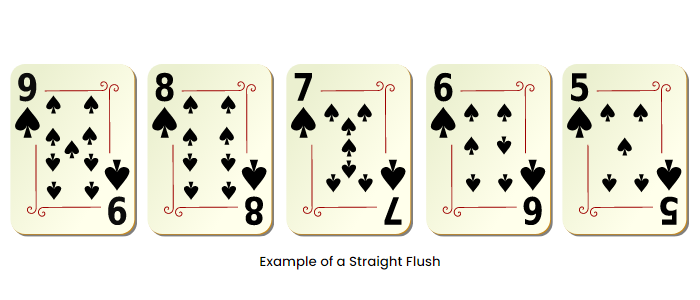
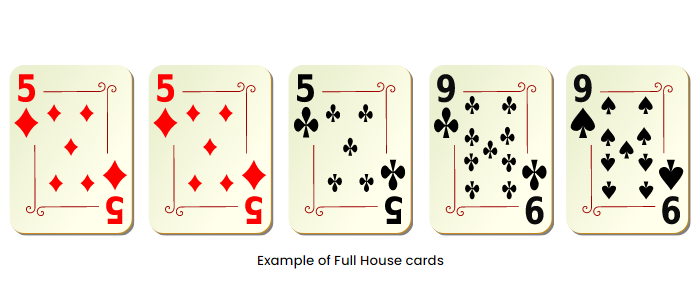
Betting Structure
Another core mechanic of poker that is important to learn is the betting structure. The betting structure establishes the minimum and maximum limit that any player is allowed to wager during the betting rounds. Just like the card values and rankings, the standard betting structures are shared across all the popular variants of poker. Here are the four standard betting structures you can expect to find at a typical poker card game:
Fixed Limit
Fixed limit poker restricts the betting amounts on a given round to a single amount, which means that all of the wagers placed in that round can only be placed in those set increments. Fixed limits are typically expressed as two numbers, which show the small bet and the big bet, separated by a slash. As an example, a fixed limit of $2/$4 means that our small bet is $2 and our large bet is $4.
The reason for having a small and big bet is to push the game to raise the stakes as the game gets closer to the showdown. Exactly which round the bet increment changes depends on the variant of the game, but the big bet generally comes into effect on the back half of the betting rounds. So for a poker game with two betting rounds (as in draw poker), the small bet is used on the first round and the big bet is used on the second. Omaha Hold’Em, which has 5 rounds, has the big bet come into effect in the third round of betting.
No Limit
“Going all-in”—a phrase used to represent betting all of the chips you have on your hand. It's one of many phrases from poker that's transcended into popular culture, and is one of the most exciting features of playing in no limit poker.
As the name suggests, no limit poker removes the maximum cap that a player can wager, thereby limiting the bet amount to whatever amount the player has in their stack. The ability to raise the stakes to such high amounts allows players to enact more aggressive poker plays, which makes for more entertaining gameplay. This is one of the reasons why the no-limit format has overtaken fixed-limit as the most popular betting structure played in poker today.
Spread Limit
Spread limit poker could be most easily summarized as a slight expansion of fixed limit poker; however, instead of a single wager increment in fixed-limit games, one can wager anything within a specified range or spread. To put it into an example, a poker game with a spread limit of $2-$10 will allow you to wager any amount in between $2 and $10 as long as it can be wagered with the available chip denominations.
Pot Limit
Pot limit poker is a betting structure that combines the relative rigidity of the spread-limit format and the high-stakes potential of the no-limit format. Pot limit poker allows players to “raise the pot,” a raise unique to this betting structure that wagers an amount based on the current amount of chips in the pot, the value of the action taken by the previous player, and the call amount of the player raising the pot.
This all seems a bit confusing, so let’s illustrate this with an example. Say there is currently a $20 pot in a $2/$4 game. The player before us makes a bet of $2, and we raise the pot on our turn. The wager amount therefore comes out to $24 ($20 starting pot + $2 previous player bet + $2 our call), and this raises the pot to $44.
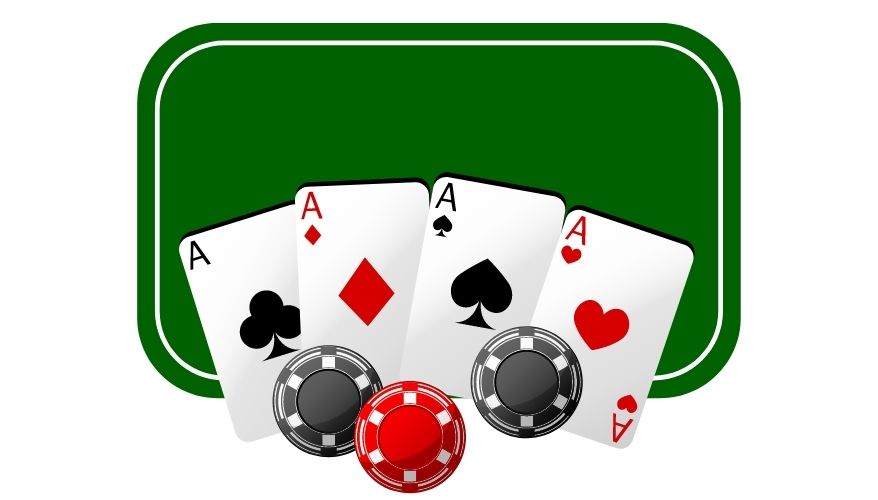
Poker Variations
Now that we’ve covered all of the core mechanics of poker, it’s time to learn how to play the games in full. As we already know, the best live casinos in Canada offer multiple variations of poker. We’ve explained the process of one of them (five-card draw poker) to illustrate the typical game process. The key thing to remember is that, while all of these variants are different from each other, all of them follow the same process of betting, card movement, and showdown.
Texas Hold’Em
Texas Hold’Em is arguably the most popular variant of poker played in both competitive and non-competitive settings at Pokerstars casino Canada. This variant falls under a general category of poker variants called community card poker, in which card rankings and values are derived from both the players’ hands and a group of cards in the center of the table (the community cards). The flow of the game goes as follows:
- Forced bets are posted, either through an ante or a blinds system.
- The dealer deals out two face-down cards to each player after shuffling the deck. The cards that belong to each player are called hole cards.
- The first round of betting begins with the same process as described in our example five-card draw game: betting sequence moves clockwise starting from the small blind to the left of the dealer, and each player has the option to call the big blind, raise, or fold.
- The dealer discards one card (called the burn) and deals three face-up community cards. These first three cards are called the flop.
- The second round of betting begins.
- The dealer discards another card, then deals an additional community card. This fourth card is called the turn.
- The third round of betting begins.
- The dealer discards another card, then deals a final community card. This is called the river.
- The final round of betting begins.
- The showdown begins, and all of the players’ hands are shown face-up.
Much like learning how to play blackjack, it is often said that one can learn to play a game quickest by learning the most popular or “standard” version of the game. And indeed, Texas Hold’Em is an excellent place to start if you want to practice your game sense and decision-making skills. The four betting rounds in the game gives players a lot of room to make big moves, while the popularity of the no-limit format lets skilled strategists turn up the stakes and exert pressure on their opponents.
Omaha Hold’Em
Omaha is another popular variant of community card poker that shares much of its ruleset with Texas Hold’Em. Because it still follows the general flow of Texas Hold’Em, we can still use the example game above as a reference for the flow of each game.
The major difference between Texas and Omaha Hold’Em lies in the hole cards; whereas the Texas variant deals out two hole cards to each player, Omaha deals out a head of 4 hole cards. This gives each hand better odds of landing more valuable card combinations. However, the best hand that each player can have in the showdown must be made from exactly 3 community cards and 2 hole cards only.
As an example, let’s consider a board (the set of all community cards) of 3♣ 3♥ 5♥ K♣ A♠ and a player hand of 7♣ 9♦ 6♣ K♥ 4♦. While an initial observation of these cards allows us to spot a straight of 7♣ 6♣ 5♥ 4♦ 3♥, this combination cannot be used as it uses three hole cards instead of the required two. Instead, the highest rank that can be attained with these cards under the Omaha ruleset is a two pair of 3♣ 3♥ K♥ K♣ 7♣.
Seven-Card Stud
Seven-Card Stud is the most popular version of stud poker, a variant of the game in which each player is dealt a seven-card hand of both hole cards and upcards, the latter of which must be kept shown to all of the other players. From these seven cards, the highest ranking hand is derived from a maximum of 5 cards, as in Omaha Hold’Em. The sequence of a typical game is as follows:
- Forced bets are posted (usually an ante).
- The dealer deals out two hole cards and one upcard (called the door) to each player.
- The first betting round begins.
- The dealer deals out another upcard (called fourth street) to each player.
- The second betting round begins.
- The dealer deals out another upcard (called fifth street) to each player.
- The third betting round begins.
- The dealer deals out another upcard (called sixth street) to each player.
- The fourth betting round begins.
- The dealer deals out a hole card (called the river) to each player.
- The last betting round begins.
- The showdown begins.
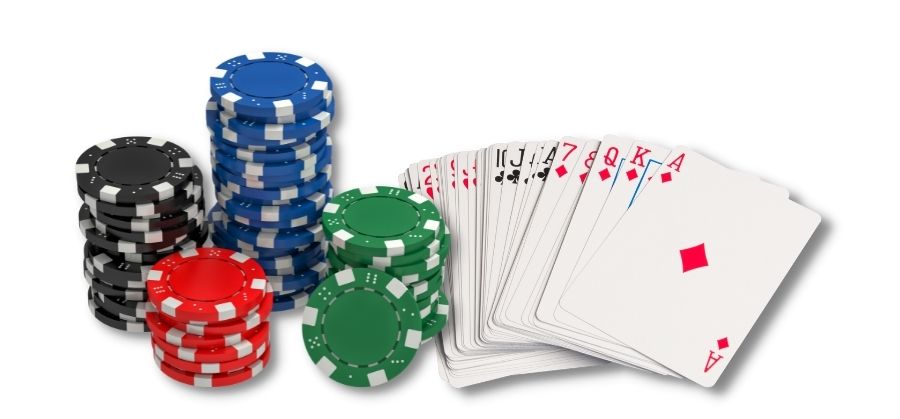
Basic Poker Strategies
Of course, we can't have a guide about one of the most strategically complex card games without covering at least a little bit of poker strategy. But because analysis and discussion of the topic can get very complicated very quickly, we'll stick to the fundamentals.
Fundamental Theorem of Poker
And indeed, a pretty good place to start would be the fundamental theorem of poker. This theorem, first put into writing in the book "The Theory of Poker" by David Sklansky, is an overarching statement of the goals of all poker strategies. The theorem reads as follows:
"Every time you play a hand differently from the way you would have played it if you could see all your opponents' cards, they gain; and every time you play your hand the same way you would have played it if you could see all their cards, they lose.
Conversely, every time opponents play their hands differently from the way they would have if they could see all your cards, you gain; and every time they play their hands the same way they would have played if they could see all your cards, you lose."
Now, it seems a bit confusing at first read, but it all becomes easier to understand when we look at the game of poker as being less like a game of cards and more like a game of information.
What do we mean by this? Well, let's consider a game of Texas Hold'Em with a board of 3♣ 3♥ 5♥ K♣ 4♠ on the river. We notice that our hand contains 3♦ 5♣, which allows us to make a full house. Our opponent, meanwhile, has a 4♠ K♥, which can make a two pair and therefore loses to our hand. For added context, our example game is in the no limit format with a current pot of $40 and we are last to act. Our opponent has bet $40, bringing the pot up to $80.
Now, in this situation we have three actions: call, raise, or fold. Since we can see their cards and know that our hand is guaranteed to beat theirs in the showdown, the optimal move would be to raise. This forces our opponent to either call (raising the pot further) or fold, allowing us to win.
However, in a real game, we do not have this information and can only resort to guessing the best action to take based on keen observation of our opponent’s playing patterns and “tells” (subconscious gestures or expressions made in response to the value of their hand). In our example, the high bet of our opponent might pressure us into thinking that they have a very strong hand, which may cause us to call or fold instead.
This is the core of the theorem, which determines victory by playing as if one already knows the value of their opponent’s cards.
Bluffing
Of course, that only explains the first half of the theorem. The second half refers to forcing your opponent to make mistakes in their decision-making by giving them certain kinds of information. In our example, if our opponent knows what cards we have but we don’t know theirs, our opponent betting the pot amount is a good move on their part. This move is called a bluff—a bet made by a player with a relatively weak hand.
In our example, the $40 bluff from our opponent exerts pressure on us as it implies that they are confident that their hand is stronger than ours. And, since we don’t know the value of their cards, we might be tempted to fold—thereby deviating from the optimum action.
Playing Poker Online
Now that we’ve learned most of the ins and outs of playing poker, it’s time to put our skills to the test with a real game. While playing at a live table will give you the most authentic experience of playing poker, the players you can expect to meet there aren’t very forgiving to new casino players.
Because of that, our recommendation for new players who want to learn how to play poker is to play at an online casino for real money. Compared to live poker, playing online has a ton of benefits that can help you learn and master the mechanics of the game at your own pace:
As we’ve mentioned earlier, live poker tables tend to be filled with more experienced players who can keep the game going at breakneck pace, and these players tend to expect the same of the others. So if you find yourself having trouble keeping up and slowing the table down, you can expect to get some mean looks. Playing online removes these interactions completely, allowing you to make your decisions in your own time.
While the Astronomical stakes are a spectacle when watching WSOP and other high-profile poker games, most players wouldn’t imagine wagering that sort of money on anything. To appeal to these casual players, online casinos have begun to offer micro stakes games, which feature minimum bets lower than a dollar—some even as low as $0.01/$0.02. With these extremely low stakes, the learning experience greatly outweighs the financial loss, and you can get better at the game without having to worry too much about your bankroll.
Another benefit of online poker is that you have access to just about every kind of poker variation under the sun. No-limit Texas Hold’Em? No problem. Fixed-limit micro stakes five-card draw? They’ve got that too. Or maybe you just want to sit down for a few minutes of video poker over drinks? You can play what you want, as much as you want, and you don’t have to worry about finding your way home at the end of the night since you can play right from the comfort of your home.
Arguably the biggest benefit of online poker for beginners is that you can study the game while you play. Since you’re playing at your own pace in front of a computer, it’s incredibly easy to pull up strategy guides and references to help you analyze and understand all of the actions in the game without the pressure of other people nagging you to keep the game moving.
Start Playing Poker
The beautifully complex game of poker is endlessly entertaining to watch, but more so to play. With so many variants, rules, and mechanics, though, it can be quite daunting to learn if you don’t know where to start. Hopefully this guide has helped you learn the basics of how to play poker. There was quite a bit of ground to cover here, what with all of the variants of the game, but with a bit of reading and in-game practice, you’ll be all set to tackle whatever games the casinos of Canada and the world has to offer.
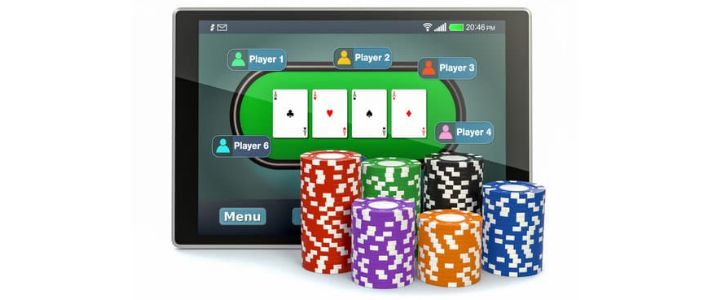
Poker FAQ
How do you win at poker?
Winning a hand of poker can be done in two ways: one, if all of your opponents fold before the showdown; and two, if you have the highest ranked hand during the showdown.
In the context of a full game, though, the metric for victory is a bit different and usually only happens after many rounds of play. Generally, the winner is the last man standing after all other players have run out of chips. This is the win condition used in most tournament formats. However, in informal games, time tends to be more limited; as such, the players in the game can agree to declare a winner based on who has the most chips after a number of rounds or at the end of the night.
Is learning poker easy?
Learning all of the poker rules needed to play smoothly in a live game is actually quite easy. Our introductory guide proves as much—with a little bit of reading and a bit of practice, you’ll be playing poker card games like a regular.
Is poker a skill or luck?
Poker is generally considered to be a game that uses a combination of both skill and luck. However, exactly how much of the game is attributable to either of the two depends on your perspective.
If we look at poker in its most basic form—that is, from the perspective of the gameplay alone—we can say that poker is a game that operates on luck. This is the case because the standard process of shuffling and dealing out the hands means that the cards that come into play are completely random.
In actual gameplay, though, we find that luck is only the tip of the iceberg. While luck dictates the cards that end up in the players’ hands, it is their decision-making skills and game sense that ultimately decides who wins and loses.
What is the best way to learn poker?
Here at InsideCasino, we are staunch advocates of “learning by doing”. And as with any other casino game, we believe the best way to learn poker is by actually playing poker.
By making all of the decisions by yourself in a real game, you will find yourself learning the subtleties of poker far more quickly than by reading about it in books. After all, “experience is the best teacher”.
But of course, we wouldn’t recommend any beginner to just jump into playing poker for real money. There are a ton of micro-stakes or even no-stakes poker games available online for you to test your strategies and hone your skills, no matter your skill level.
What should you not do in poker?
While there are many things you shouldn’t do in a game of poker, the most important of these is to keep information to yourself. Not only does this disrupt the very core of poker, it also ruins your odds of beating your opponents.
Since its roots as a simple pastime played by any group of people with a deck of cards and anything to wager, poker has always had the rule of “keeping the cards to yourself”. As the game grew more popular over the years, poker became less of a game of cards and more of a game of information. We can still see this in practice today, as most (if not all) poker strategies are essentially ways to act based on limited information about your opponent’s hand while giving away as little information about your hand to them at the same time.
This has led to the development of a “poker etiquette” of sorts—a list of unspoken rules in the game of poker. While there are too many of these rules to list and explain here, we’ll share a few of the most common that you will see in other players or even in your own gameplay:
- Don’t try to peek at other players’ cards. This is called “angle shooting”, and while not technically considered cheating, it is bad practice and generally unethical.
- Don’t act out of turn. As we saw in our example game flow, poker follows a very strict game sequence, which starts from the small blind position and continues clockwise around the board. Making your action while someone else is performing theirs disrupts the flow of the game for everyone on the table.
- Don’t take too long to act. While each player should be given their time to weigh their options before making their action, it is never a good thing to take too long and drag the game on for any longer than it needs to. If you have to go into deep consideration before the flop only to fold the next round, you’re only going to annoy everyone else.
What is the easiest poker game?
Of the many variants of poker that we’ve covered in this guide, the one that is arguably the easiest is called video poker. This is a poker variant developed in the 70s to be installed and played through a machine similar in size to an arcade cabinet.
In terms of gameplay, video poker adopts the general rules and flow of five-card draw and simplifies it to be playable by one person at a machine—as such, there is only one betting round, and the showdown happens after the draw. Unlike table poker, video poker uses a payout table to determine winnings, which itself is based on the rarity of card rankings. Below is the pay table used in “Jacks or Better” video poker:
| Name | Payout |
|---|---|
| Royal Flush | 800:1 |
| Straight Flush | 50:1 |
| Four of a Kind | 25:1 |
| Full House | 9:1 |
| Flush | 6:1 |
| Straight | 4:1 |
| Three of a Kind | 3:1 |
| Two Pair | 2:1 |
| Pair (Jacks or Better) | 1:1 |
| Others | 0 |
Can 2 players play poker?
Although the typical poker game usually has at least 5 people around the table, 2 player poker games do exist. These are called heads-up games and can be played with any set of poker game rules that are otherwise played with multiple people, but with some slight adjustments to fit the two-player dynamic.
Heads-up games hold a certain mark of prestige among high-level poker players. The reason for this is that heads-up games remove many of the ancillary considerations a player needs to make when playing against multiple people. Condensing these strategies into a one-on-one duel format shows what some believe to be a poker player’s true level of skill in the game.

